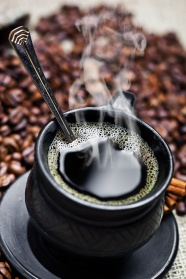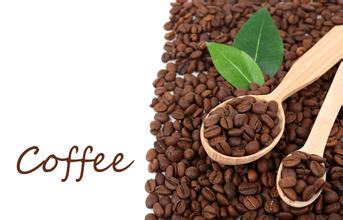Introduction to the Origin of civet Coffee the characteristics of civet coffee
Kopi Luwak (Indonesian for coffee), Luwak is Indonesian for a wild arboreal animal commonly known as the "Civet."
In Sumatra, Indonesia, the local people call the civet Musang instead of Luwak, and Kopi Musang means civet coffee, commonly known as "cat shit coffee." From Coffee Fine Science.
Cat poop coffee, Indonesia, one of the world's most expensive coffee. Indonesia grows a lot of coffee, and there is a wild animal called the civet, an omnivore with a pointed mouth and dark gray fur. The favorite food is fresh coffee beans, which are fermented and digested in the body and eventually discharged as cat feces. Feces are coffee beans and are the most expensive feces in the world. Because of the scarcity, the price is very expensive. Civets are found in Indochina, India (northeast), Bangladesh, Bhutan, Sikkim, Nepal and Kashmir, but only Sumatra civets, or Indonesian civets, can produce cat feces coffee.
Civet faeces
Civet faeces
After processing and roasting, cat poop coffee became a luxury coffee drink that spread to luxury kingdoms around the world. Local coffee farmers, in pursuit of high profits, capture wild civets and raise them at home so that they can produce more cat poop coffee. However, the quality and taste of cat feces coffee produced by raised civets would be correspondingly inferior. Even so, production of this coffee is scarce and not affordable for all coffee lovers.
The coffee comes from the droppings of an animal called a civet (commonly known as a civet in Indonesia). Although it comes from smelly poop, it tastes sweet and has an indescribable sweetness. This wild civet likes to eat fat and thick coffee fruit, but the hard fruit core (green beans) cannot be digested and excreted with feces. After washing, it becomes Kopi Luwak coffee green beans! Many people call it cat shit coffee. Indonesian people found that the coffee beans fermented by the civet stomach were particularly thick and fragrant, so they collected the civet feces, sifted out the coffee beans, and brewed them to drink. Due to the scarcity of production and the unique fermentation process, the flavor was greatly different from ordinary coffee. Traditionally, coffee fruit has been used
civet
civet
Luwak, however, uses natural fermentation in vivo to extract coffee beans, which have a special flavor.
It is said that early Indonesian coffee farmers regarded civets, which ate ripe coffee fruits, as mortal enemies, but at some point it began to occur to people to pick coffee beans from civets 'droppings to make coffee with unique flavor. Coffee experts everywhere have tried it and marveled. Since then, local farmers have spent much of each day collecting civet droppings in the forest during coffee ripening season.
History Edit
M.P. Mountanos, the company that first introduced Kopi Luwak coffee to the United States, pointed out that when he first heard about this kind of in vivo fermented coffee, he thought it was a joke in the industry and didn't take it seriously. Later, he saw a special report on Kopi Luwak in National Geographic magazine. It took seven years to find a stable source of supply and began to introduce small quantities into the United States. How does this coffee taste? Generally speaking, Indonesian coffee has an earthy and herbal flavor, and its consistency is also the highest in all continents, but Kopi Luwak has a stronger earthy flavor and consistency, which is almost close to syrup. The aroma is very special. If you don't like Indonesian coffee in the first place, you will definitely hate Kopi Luwak. If you prefer the earthy smell of old beans, you may love this alternative coffee. Experts who have tasted Kopi Luwak offer polarized reviews, some likening it to human gourmet coffee. Although it was top-grade coffee, it was a personal preference to be willing to spend thousands of yuan on a cup of cat feces coffee.
Production method Edit
manufacturing method
Production method (4 photos)
Roasting process of Luwak coffee beans:
1. Civets love to eat ripe red coffee fruits on coffee trees;
2. Pick undigested coffee seeds from cat feces;
3. Remove the silver-gray film of coffee seeds and wash it with water and dry it in the sun;
4. Roasted to make Luwak coffee beans.
Production Skills Editor
1. After Indonesians remove the silver-gray film on the appearance of coffee beans, wash them with water, dry them in the sun, and then stir fry them to become cat feces coffee beans.
2. Only about 150 grams of coffee beans can be extracted from a catty of civet feces, which will cause 20% loss during the roasting process. Due to the unique raw materials and production process, this kind of coffee can be said to be very rare. The annual supply of coffee beans worldwide will not exceed 400 kilograms at most.
Traditionally, coffee fruit is washed or sunned to remove excess parts and remove coffee beans, but Luwak obtains coffee beans by using its natural fermentation in the body of the civet, so it has a unique flavor.
Main features Edit
Civet Bali Coffee Bean
Civet Bali Coffee Bean
Coffee beans generally go through the process of fermentation of the shell. Coffee beans are in the intestinal tract of the civet. Special bacteria provide a unique fermentation environment. The flavor becomes unique and especially thick and mellow. Coffee beans fermented by civet intestines are especially thick and fragrant.
Eva, the owner of Te Cafe, is a coffee enthusiast who travels around the world every year to collect rare products. She told reporters that "cat poop coffee" was once a tribute from Indonesia to the Dutch royal family. At that time, the industry regarded this coffee with the name "cat poop" as a joke, until National Geographic magazine carried a special report on this, everyone gradually became interested in this "cat poop coffee".
expensive
"Cat poop coffee" is the world's least produced coffee, a bag of 50 grams of coffee beans worth more than 800 yuan, only 4- 5 cups of coffee. In terms of conversion, a cup sells for about 200 yuan. Indonesia's largest coffee supplier, Fireboat Group, produces a small gift box of civet coffee for 600 yuan and 50 grams. The packaging is extremely luxurious, while the asking price of 100 grams is more than 2000 yuan. The annual output of wild coffee in the world does not exceed 400 kilograms. Villagers in these areas now collect not only wild ruaka waste but also caged ruaka. Large pots of picked coffee cherries were placed in front of Ruwaka, who was hungry and had no choice but to eat all the coffee cherries. The taste of the coffee produced in this way is naturally greatly discounted. "Rare is expensive", which has led to the high price of Kopi Luwak, a rare treasure. I'm afraid you can prepare 50 pounds for a cup of coffee, and you may not find it anywhere.
★ A cup of coffee made from 12 grams of cat feces coffee powder sponsored by Huochuan Group at the 2010 Shanghai World Expo is 380 yuan, and the daily limit of 12 cups is in short supply.
★ In Bali, a cup costs more than 200,000 Indonesian rupiah, equivalent to more than RMB 150.
★ In the United States, 1 kg of cat poop coffee beans goes up to USD 1200. It is always around USD 1000 on the international market.
In Britain, a glass costs 50 pounds (RMB 500).
Cat poop coffee processing
Cat poop coffee processing
In Indonesian,"Kopi" means coffee, and "Luwak" is the Indonesian name for "civet." It is said that the annual production of this coffee does not exceed 500 pounds, and the price per pound ranges from $300 to $800, depending on the year, because there is no fixed production every year.
Luwak coffee remains a veritable luxury on the international market, not least because it is made not by humans but by wild animals. Traditionally, coffee fruit is washed or sun-dried to remove the peel, pulp and sheepskin layer, and finally the coffee beans are taken out, but Luwak coffee is made by natural fermentation in wild animals. Moreover, these wild animals are only found on small islands like Indonesia. The time and place of their appearance are mysterious, and their numbers are decreasing day by day. Indonesia has claimed that conservation and breeding have helped keep the civets stable, but the digestive system that created them to tempt human taste buds has nothing to do with industrial-age products.
"Civets" are omnivores. They are solitary and nocturnal. They inhabit tropical rain forests, subtropical evergreen broad-leaved forests, mountain shrubs or hills, mountains, grass and other places below 2000 meters above sea level. Its food includes small mammals, birds, amphibians and reptiles, crustaceans, insects and plant fruits, seeds and so on. "Civet" likes to choose the most ripe, sweet, full and juicy coffee fruit in the coffee tree as food, and the coffee fruit passes through its digestive system, only the pulp of the fruit is digested, and the hard coffee beans are then excreted intact by the "civet" digestive system. This is the "natural fermentation method" that was once scorned by Americans. It is said that when Americans heard that there was a way to make coffee in this way, they thought it was a fantasy until it was reported by National Geographic magazine.
The world's most luxurious coffee, the world's most expensive coffee, the world's rarest coffee…
Kopi Luwak has always been described like this, and it sounds like a boring anecdote.
It reminds me of Oscar Wilde.
People tend to pay too much attention to the price of things, and often ignore their own value…Forget the rumors of clumsy and useless embellishments,
Let's start a magical cat poop coffee tour... --Coffee

Important Notice :
前街咖啡 FrontStreet Coffee has moved to new addredd:
FrontStreet Coffee Address: 315,Donghua East Road,GuangZhou
Tel:020 38364473
- Prev

The price of Kopi Luwak coffee the origin of Kopi Luwak's culture Kopi Luwak
Gourmet coffee has soft acidity and attractive aroma, which is absolutely worth enjoying. Coffee exports from Tanzania (Tanzania) play an important role in the whole national economy. Bean-shaped berry coffee is very productive and is said to be more fragrant than ordinary coffee. Generally speaking, the coffee beans in Tanzania have an extraordinary quality. For example, in the neighborhood of Kilimanja
- Next

Introduction of Blue Mountain Coffee the characteristics of Blue Mountain Coffee the Culture of Blue Mountain Coffee the Origin of Blue Mountain Coffee
Blue Mountain Coffee refers to coffee brewed from beans from the Blue Mountains of Jamaica. According to the grade, it is divided into Jamaica Blue Mountain Coffee and Jamaican Alpine Coffee. The Blue Mountains are located in the east of the island of Jamaica (Jamaica). Because the mountain is surrounded by the Caribbean Sea, whenever the weather is clear, the sun shines directly on the blue sea, and the peaks reflect the bright blue light of the sea.
Related
- Does Rose Summer choose Blue, Green or Red? Detailed explanation of Rose Summer Coffee plots and Classification in Panamanian Jade Manor
- What is the difference between the origin, producing area, processing plant, cooperative and manor of coffee beans?
- How fine does the espresso powder fit? how to grind the espresso?
- Sca coffee roasting degree color card coffee roasting degree 8 roasting color values what do you mean?
- The practice of lattes: how to make lattes at home
- Introduction to Indonesian Fine Coffee beans-- Java Coffee producing area of Indonesian Arabica Coffee
- How much will the flavor of light and medium roasted rose summer be expressed? What baking level is rose summer suitable for?
- Introduction to the characteristics of washing, sun-drying or wet-planing coffee commonly used in Mantenin, Indonesia
- Price characteristics of Arabica Coffee Bean Starbucks introduction to Manning Coffee Bean Taste producing area Variety Manor
- What is the authentic Yega flavor? What are the flavor characteristics of the really excellent Yejasuffi coffee beans?

